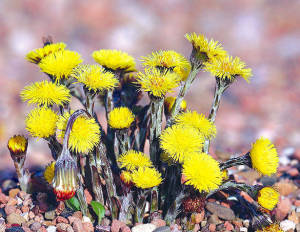Patches of place
By Bridie McGreavy
 Early last spring, a curious yellow flower with a translucent stem popped up all over my yard in Orrington, which is just south of Bangor. They were everywhere, lining roadsides, covering ditches, and along the lakeshore. When I first noticed them, I gave them the very unscientific but fitting label “weird dandelions.†They looked just like dandelions, but not quite.
Early last spring, a curious yellow flower with a translucent stem popped up all over my yard in Orrington, which is just south of Bangor. They were everywhere, lining roadsides, covering ditches, and along the lakeshore. When I first noticed them, I gave them the very unscientific but fitting label “weird dandelions.†They looked just like dandelions, but not quite.
Within weeks, the yellow flowers produced fluffy white seeds, again like dandelions but fuzzier and not as fun to blow into the wind. The plant’s lily pad-shaped leaves emerged just as the flower stems folded and faded. It was about this time that I arrived at the April section of Mary Holland’s book Naturally Curious (by the way, when I was originally thinking about this “Earth Notes†column, I considered a book review of some of my favorite books and Holland’s was at the top of my list. Summary: one of the best natural history books ever written. If nature interests you, you’ll love this book). I turned to page 62 and there were my weird dandelions, yet Holland informed me that while these yellow flowers are similarly in the aster family, dandelions they are not. Their common name is coltsfoot, Tussilago farfara, so-called because someone else likely looked at their lily-pad leaves during an era when colts’ feet were a more familiar object. I also learned from Holland, because this is the kind of interesting information she includes in her beautiful book, that coltsfoot is also known as clay flower. This proved to be a clue to a mystery I was about to unravel.
What stumped me when I first saw this plant was that it was so common yet I had no idea what it was. I am by no means a botanist, but I have a pretty solid place-based knowledge of the plants in western Maine and I am relatively sure I have never seen coltsfoot in or around Bridgton (a letter to the editor would correct this perception if you happen to have it growing in your yard).

NOT A WEIRD DANDELION, but rather this colorful plant that can be found along the roadside is a coltsfoot.
Why so common in one place and not another? Orrington is at roughly the same latitude as Bridgton. The climate is about the same and the forests are nearly identical. For an answer to this mystery, I turned my gaze dirt-ward. From the first days of our arrival in our new home, I noticed that the soils were decidedly different, with much more clay than the familiar sand and gravel till of inland Maine. Eleven thousand years ago, as the Laurentide ice sheet melted, my yard where the coltsfoot now grows was at the bottom of the ocean. The fine clay that gives coltsfoot its nickname settled out of the water during this time, while Bridgton stayed well above the tide.
When I realized the relationship between weird dandelions and different dirt, I felt a familiar sense: a connection to the place in which I now live. My story here is how the patches of a place become knitted into an awareness of the broader patterns of a landscape. When we notice the subtleties, we become attuned to changes across space and time. We find a weird little yellow flower and dig into its roots and in turn, it digs into ours. These simple patches of yellow flowers and clay soil when stitched together remind us that everything has a story and it is a story of complexity and connections. But for all the complexity, the story of a place starts with a simple observation: I wonder… and the roots grow from there.

